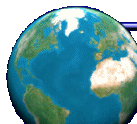A nice little town
( NB: this information dates 1991 - for the
eruption of the volcano in 2002, see at the bottom of page)
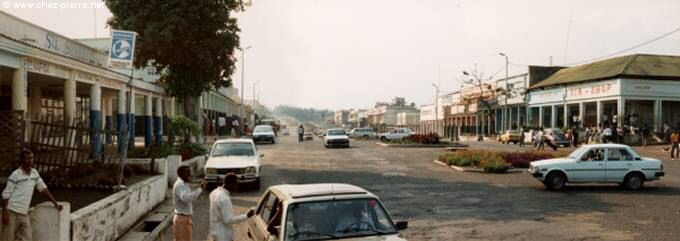
Goma
is situated far East in Zaire (at present "Democratic Republic of Congo"),
North of Lake Kivu, at the border with Rwanda. On the other side of the border
is its "twin" city: Gisenyi, where we normally were going for shopping
and fun, but especially for the mail or phone - impossible or difficult things
on the Zairean side. Regrettably, the border was quickly closed, after the invasion
of Rwanda by Rwandese rebels who came back from Uganda...
Goma is an average
size city (about 300 000 inhabitants at this time if I remember well), made of
a rather pleasant centre (photo above) and of suburbs.
| 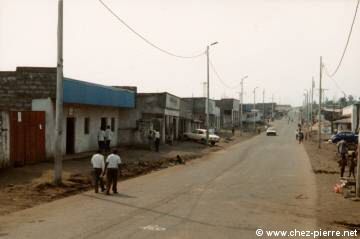
Airfield road | In
the North, some factories, businesses and the airfield, along the road towards
the Rwindi. If you continue a few hundreds kilometres, you can go to Uganda. |
In the East, nice districts and some hotels before arriving
at the border with Rwanda, the unique "real" exit in case of problems,
unfortunately closed shortly after my arrival.
In the South, the Lake and
the former residence of the president, occupied by servicemen.
On the West
one passes next to the enormous "township" where the majority of the
Zairean population lives, then one turns southward passing by the lake. It then
goes by the new presidential residence (amusing : the road is lit and asphalted
from the airfield to the residence, not anywhere else ;)) then by beautiful
districts of villas on the lakeshore, by the very beautiful Karibu hotel, finally
one arrives at the Canadian Base : civil base for the Canadian volunteers, numerous
in Goma (we used to play volleyball there, on Sundays). The road continues towards
the Green Lake (see "Balads in Jeep"), the
Masisi (magnificent region!), then Bukavu in the South of the lake and farther,
Bujumbura in Burundi.
In Goma's centreWe find "everything"
: the post office (which worked so-so), banks, and businesses. Many
of these were held by Pakistanis and many goods were for sale, but irregularly
because of the war and the plunders during the riots. When there was some meat
or some cheese, it was better to buy a good quantity of it... At the risk of losing
everything with the next power outage ! The other reason:
the exchange rate, which was 12 Zaire / BEF when I arrived, and in one year rose
to more than 900 Zaire / BEF; and the persevering rumour of a demonetization pushed
the shop owners to change the prices up to twice a day ! |
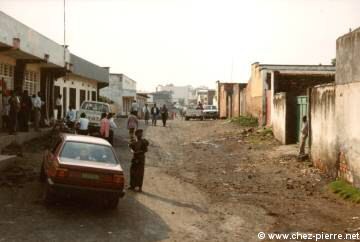
In the lanes around the centre |
So, when I got my salary at the school, I rushed in the shops to spend the most
possible of it, knowing that from the next day these dirty and stinking notes
would have much less value !
You could also find there European products
(cooked meats and canned cheeses, pastas, wines...) but those were extremely expensive
: it was better to appreciate the local products.
As a matter of fact, it
is in Goma that I got used to drinking my coffee without milk and without sugar,
because the sugar was expensive, and there was no milk except for "Nido"
(powdered milk). Fortunately, I had a very good cook!
The luxurious products
that I bought myself ? A new television and a second-hand video recorder, good
tires for the Jeep ; a small bottle of champagne and a can of pâté
for the new year.
The supply in water was also a big problem : even boiled
30 minutes then filtered twice, the tap water was infected and dangerous because
drawn directly from the lake, where poured the sewage and where it was not so
rare, even before the worst of the war, to see a corpse floating... Let's add
that it's a volcanic lake of which the emanations sometimes killed rowers who
were in the wrong place, at the wrong time.
And as local soft drinks (Coca,
Fanta...) were unappetizing and on base of this same water, one understands that
those who had money were on Whiskey, the others on beer...
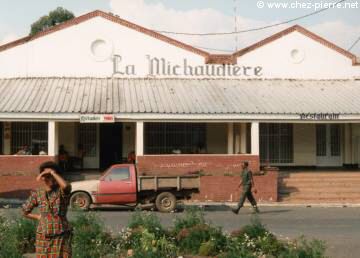
My Temple !
( In the foreground, a friend and mom of a
pupil) | A fix...With
these supply problems, and particularly during the long evenings without electricity,
I had found a place where I could indeed eat, in good company and for little money
(I had a very small salary !) : La MichaudièreI
had gone there the day after my arrival and had met there Mussa, the new manager
who had just arrived from Kinshasa where he had had to leave wife and children. In
the adversity (we both just landed and knew almost nobody) we tied up a very deep
friendship, even if we lost contact after my departure and with the war. I do
not know if he survived, because he was employed by a general of Kinshasa... |
But Mussa was always there when I was there, and if
I think I returned it well to him, I shall never forget the risks that he sometimes
took for me (even giving me a gun to defend myself -I declined the offer- or lending
me his "phonie" during several months).
So I was a more accustomed
to "La Michaudière" than to the "Nyira" which all the
expatriates frequented dedicatedly. I went there from time to time all the same,
notably because the bosses (Raoul and Mitzi) were very nice, but generally everybody
knew where to find me... At "La Michaudière" I had a great cafe-terrace
right in the centre, where I could meet any sorts of people (not only expatriates)
and have a good time.
Daily smileLiving in Goma in the 90s
was not always funny (is it now ???) so you will understand that each looked for
occasions to smile... It is the funeral parlor which helped
us the most, on the western road... Just look closely at
the photo (enlarge by clicking it if needed) and track down its name ("The
Good Seed") So real... ;) |
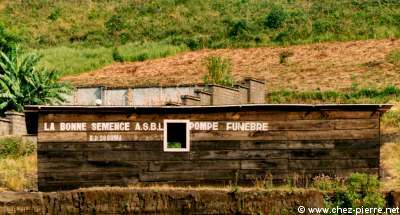
|
Managing, no matter how
When
one lives in a town in the centre of Africa, in the middle of the riots, of the
civil war and of the natural disasters, one quickly learns to manage. Example
?
The fuel was rationed starting October 1990 : when a gas truck managed
to pass, it was going to furnish the servicemen at first. The possible rest was
then at first sold to the "persons who had right of way" (state and
important companies...) and if there was some leftover it went to the gas stations,
where lines of several hundred cars formed then. A part of the "person who
had right of way" fuel was resold in the black market, but often cut with
water or alcohol, and at high prices...
Nevertheless I have never lacked
gas for my car : I received it on demand, by 200 liters barrels at home... In
exchange for services to the family of the leader gas station attendant ;)
Yep,
plain barter. I even exchanged the last barrel against the rent of a minivan with
driver, just before my departure, to go take pictures in the city, some of which
you saw on this page, in a more secure way (or almost: I was all the same assaulted
at the market) !
It is in the same way that I had video cassettes for the
long Congolese evenings (in Goma, the sun gets up imperturbably at 6 o'clock and
goes down at 18 o'clock, all year long).
Having said that, please, do not
imagine that everything was to be paid for in Goma: I received (and gave as well)
so much free of charge, so much appreciated the generosity and the spontaneity
of the majority of the Zairean and of the expatriates in Zaire... I stayed only
one year in Goma, but I would need much more than a page to tell you how much
I was at the same moment swindled (but always openly and with a smile) and at
the same time welcomed, invited, fed... This is certainly part of the African
magic !
Map
of the flow of lava of the Nyiragongo volcano
In January, 2002 in Goma, R.D.
Congo :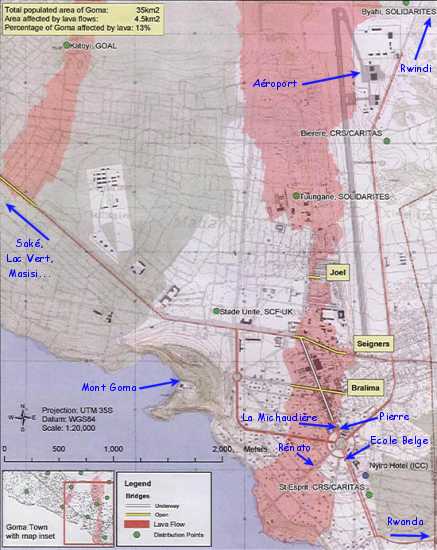
| February, 2002
Eruption of the NyiragongoAs
you know, I left Goma in 1991. But I try to stay informed of course, notably thanks
to the friends whom I still have there. January 17, 2002On
Thursday morning, the volcano woke up after about twenty years of relative quietness.
In the evening, a flow of lava, several hundreds metres wide and 6 metres high
at places, invaded the town centre then threw itself into the lake. The
major part of the population took refuge in nearby Rwanda but did not stay there
for a long time : at the end of the eruption, three days later, people returned
to assess the damages of the volcano... And of the plunders which followed. On
the map, you can well see the route of the main flow, in red. A third of the airfield
runway was covered, the whole town centre (1st and 3rd photos of this page), as
well as part of the "township" and of the residential area of the South.
|
|
On the other hand, the lava stopped 3 metres from my home (see
the page "My home", with a
photo of the volcano in 1991), and "La Michaudière" (4th photo
of this page) benefited from the same luck. The Belgian
School was also spared, by less than 100 metres...
My friend Rénato is one of
those who lost everything : as you can see on this
Giancarlo Davite's photo (as the next one, dozens
of Goma's photos at the end of January here),
his house but also his company buildings were completely
covered by the lava, with all his belongings, his
vehicles... He got out with the clothes he wore,
deprived even of his passport.
| 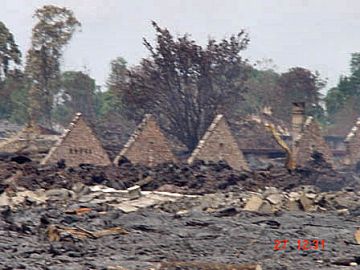
|
|
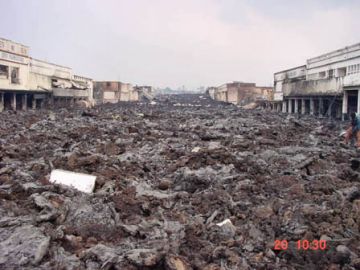
| Another friend, dad of one of my pupils,
lost his house and his stores whereas his shop was spared... As
you can see on this other Giancarlo Davite's photo, Goma's centre, where most
businesses were located, has been invaded by the lava, provoking monstrous fires
followed by the plunder of the little that was left... Have
the inhabitants of Goma still tears to cry on the misfortunes which swamp them
continuously for so long ? Will they finally know a well deserved respite, in
this magnificent region ? I wish it of all my heart... I have many thoughts to
you all, dear friends, colleagues, alumni... |
Next page : At school
